What makes a great popping cork for speckled trout and redfish? This guide explains all the features any angler should know to make the best choice possible.
I've never created a guide like this one because, well, doing so just seemed so difficult. How could one possibly choose the best popping cork? There are just so many out there.
Besides, a good argument exists that there are far better ways to catch speckled trout and redfish than using a popping cork. I'd go so far as to say that fishing with a cork is more of an introductory way to inshore fishing!
But fact of the matter is the popping cork is a mainstay in any inshore angler's tackle box. Surely people notice this so is it any surprise they cannot help but ask, "Hey, why do you use that one over all the others?"
It's a good question and the reason why I've finally created this guide. Most of the popping corks you see here are models I've fished with and this guide is built from those years of experience.
Best Popping Cork For Speckled Trout And Redfish?
Catch me on any fishing trip for speckled trout and redfish in Louisiana, and I will always have a spinning rod rigged up with a popping cork. Always. That's because it's a versatile tool that has proven itself and stood the test of time.
So which popping cork is best for catching speckled trout and redfish?
The answer: it really depends on you and your needs. Those range from fishing conditions to your own personal situation and, in order to identify those needs, let's begin with what a popping cork's job is in the first place.
What is a popping cork's job?
The answer could be simplified as: to alert fish to nearby bait then alert you when the fish takes the bait. To meet these needs popping corks come in many designs, shapes and sizes, the majority of which we will explore below. Learn them and you will be able to decide what is best for you.
You will find that no single cork fits every scenario you can possibly fish.
Ultimately, it will take time on water to build experience and learn what you really do prefer.
That's part of the fun! Inshore fishing is a journey, and not a destination.
Learning Popping Cork Design
To meet the many needs of inshore anglers, popping corks come in various designs, shapes and sizes. Let's take a look at these:
Weight
Some popping corks come weighted, others don't. This can be important to you because (generally speaking) heavier rigs or lures are easier to cast.
If you're not sure how heavy you should go, you should check the lure weight rating on your rod, as described in this guide to choosing the best fishing rod for inshore fishing.
Typically, you will find that most weighted popping corks weigh about 3/4 ounce.
Which color is best on a popping cork?
I wouldn't say color has an impact on the fish so much as it does you, the angler.

Most people have a hard time seeing chartreuse popping corks in bright conditions, especially in any kind of sun sparkle reflecting off the water's surface.
Some people say that green is not bright enough, while most find that bright red or orange is the perfect balance.
I'd use different popping cork colors to help customers identify "their" rod during a fishing trip, so they could get bait in the water faster, instead of debating which rod belongs to who (and wasting valuable fishing time).
How color selection works for color blind people, I do not know. So, if you're color blind and know a color that works well for you then please share in the comments at the end of this guide!
Swivels
It is pretty much mandatory to have a swivel attached to at least one end of your cork to keep twist out of your main line.
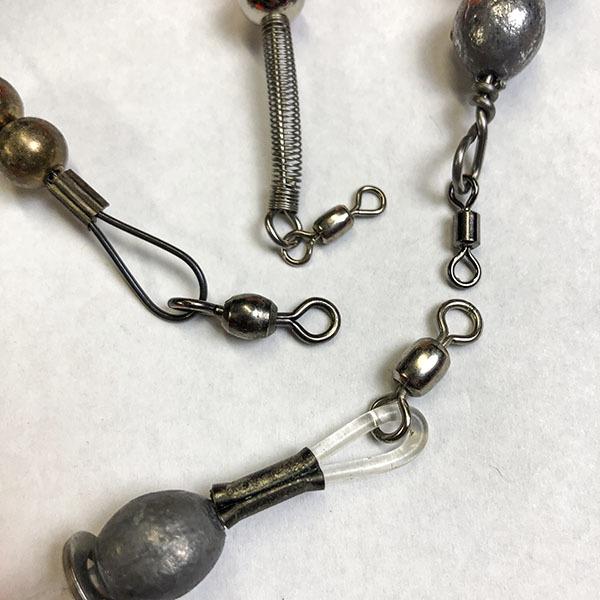
Line twist is bad, reducing casting performance, causing wind knots and worse! Sure, swivels help keep it away, but I still recommend that you regularly de-twist your fishing line using these instructions.
How Your Popping Cork Attaches: Stem vs Clip-On vs Wrap-On vs Slip
Generally, you will come across four kinds of popping cork that are differentiated by how they attach to your main line. They are:
- stem corks
- clip-on corks
- slip corks
- wrap-on corks
Stem Corks
Stem corks are defined by their stem running through their center with loops at each end to tie your main line and leader line. This stem is usually a light wire with a loop twisted in each end to tie your main line and leader to.
However, these stems are easily bent and, once they are, never seem to perform the same again, even after being bent back in place.
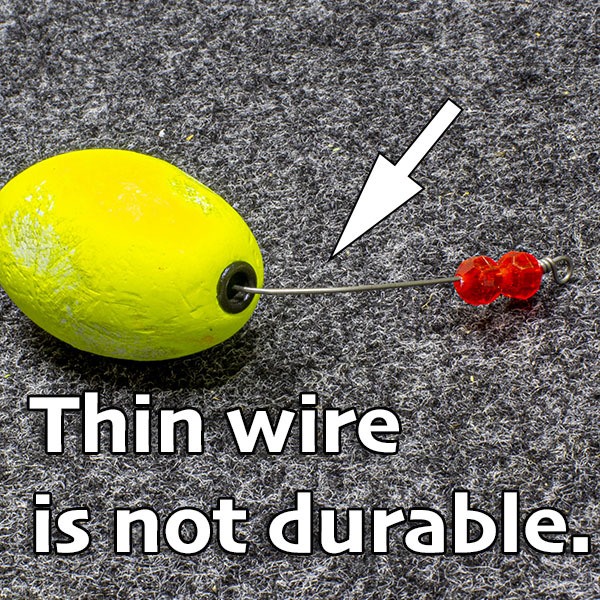
Because of this, some tackle manufacturers have opted for a heavy duty wire that is less likely to bend when hooked up to a strong fish.
This is what you see on Four Horsemen popping corks. They are far less likely to bend and – if they do – it is not so bad that its action is compromised.
Other tackle manufacturers have opted for a flexible wire, which is smart, but it seems they do not create the same smacking sound as a stiff wire because the cork and beads do not readily fall down a flimsy wire.
Corks equipped with a flexible wire tend to be secured with crimps on each end, adding a potential weak point.
If that crimp was made on a Friday, you can count on it breaking at an inopportune time.
It's worth noting that other manufacturers (like Boat Monkey Floats) will use a length of high-strength monofilament as a flexbile stem (which is pretty darned smart if you ask me).
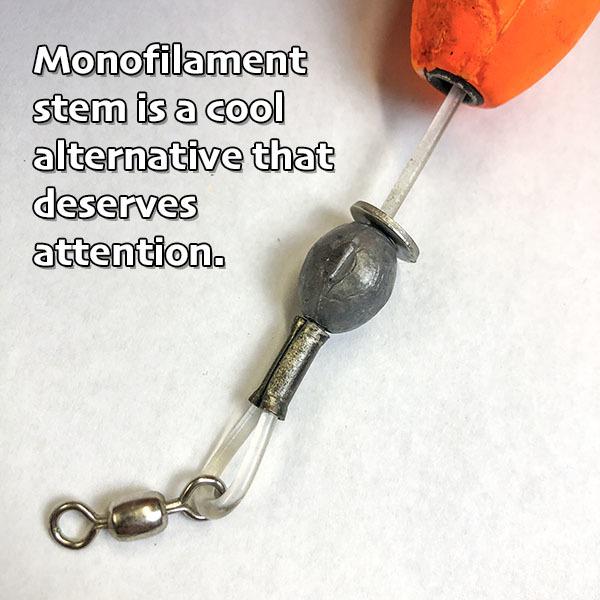
Wrap-On Corks
The stem on these corks is almost always made from plastic and features a hollow center that allows this cork to double as a slip cork (that you will read more about shortly). Your fishing line can be wrapped around the stem and inserted in the body, making the cork detachable.
However, you should know that this design is largely outdated and the cork tends to accidentally come off after extensive use.
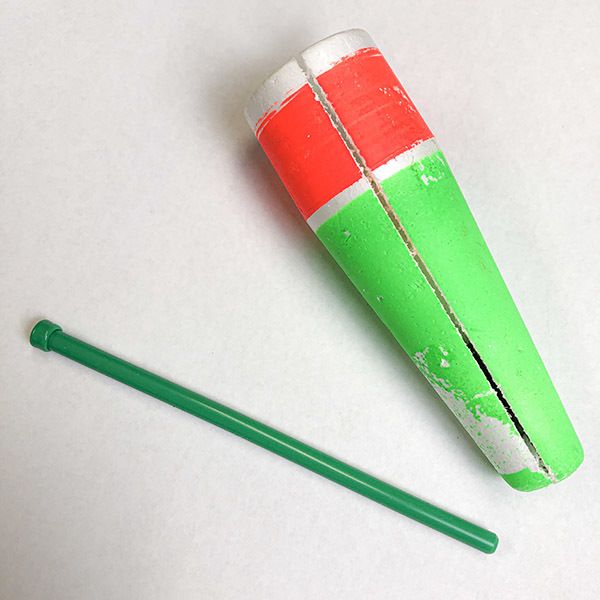
I fished with them a bunch when I was a kid, but no longer do.
Other Wrap-On Designs
You should know that there are other wrap-on designs, like what you see in the Versamaxx popping corks.
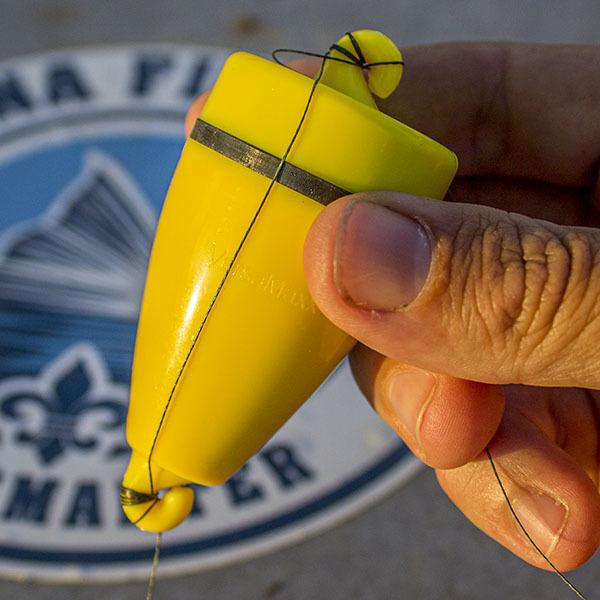
The Versamaxx Bolt features a small spool on its bottom that allows you to make on-the-fly adjustments in leader length between casts.
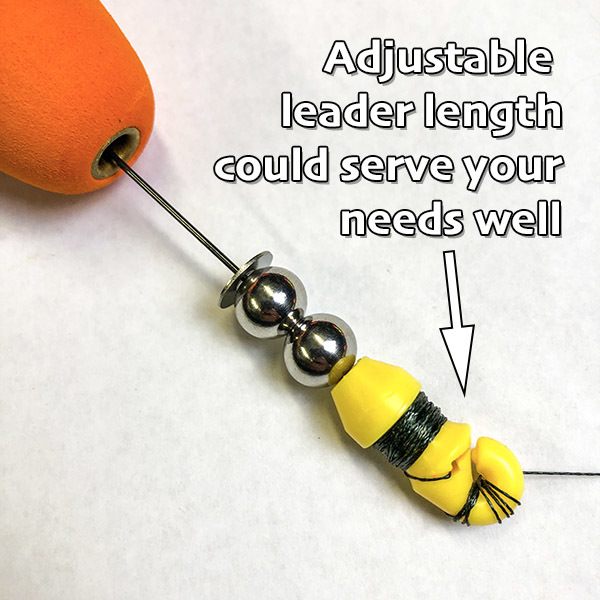
Slip Corks
This kind of popping cork is not designed to attach to your main line, but rather let it pass through it (where a stem would normally go).
A bobber stop and bead is used to catch the slip cork and, depending on where you put it, determines the depth of your bait.
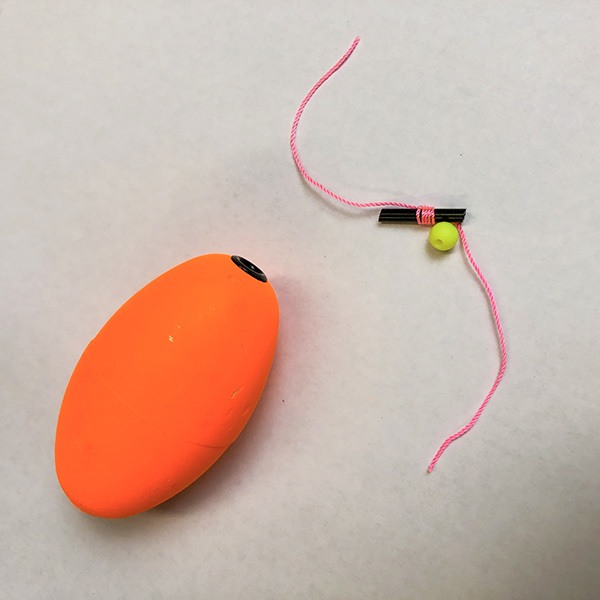
This allows you to fish deeper water without having to cast an obnoxiously long leader line.
Slip corks don't really fall into the same category as all the other popping corks listed here, but they are worth explaining because you will see them at the tackle store.
After all, this guide is designed to give you the information you need to make the best purchase for yourself, right?
Clip-On Corks
The clip-on cork has stood the test of time as the "go to" for inshore anglers. It is easily attached and removed, making a single rod count as two. That is why I employ clip-on corks with the Inshore Rig, it's easy to fish the top and bottom of the water column.
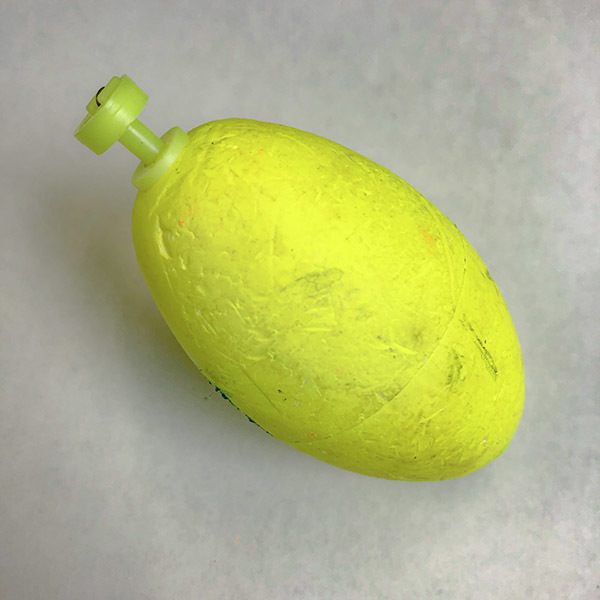
While they are more economical compared to other corks in this guide, it's best to purchase a bag of them, rather than one at a time, because they are not as durable as they could be.
Popping Cork Material
This may sound crazy to you, but not all popping corks are made of cork! The majority of what you see in stores are actually made from a dense Styrofoam.
You also see corks made from plastic, but they tend to weigh too much and are prone to cracking and leaking. Experience has revealed to me that you really don't want plastic!
Popping Cork Shape: Cup vs Oval
This is another aspect of popping corks that inshore anglers love to discuss. Popping corks featuring a cup tend to move more water when popped (making more noise), whereas oval corks are more subtle.
So, with this in mind, it makes sense that cup-shaped corks are more easily heard by fish during periods of loud noise, like a windy day or in the immediate area of a natural gas platform.
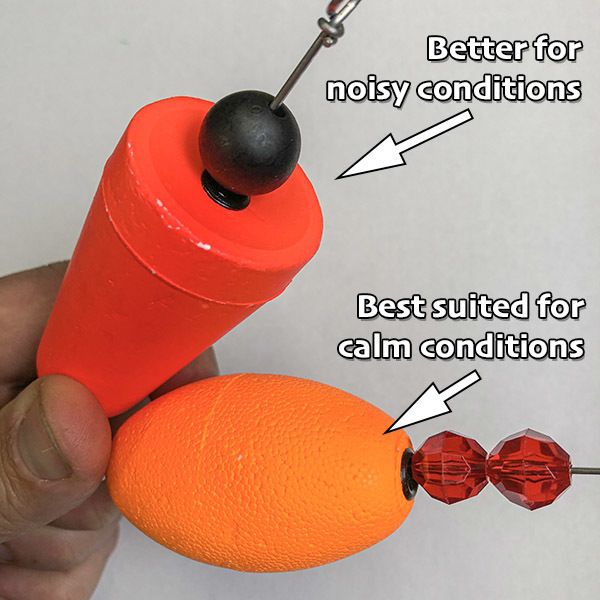
However, flat calm days present a different scenario: it's so quiet that a cupped cork may not appeal to fish as much as something more subtle, like an oval-shaped cork.
Rattle, Clack or Silent?
I feel this falls into the same noise scenario as cupped vs oval shaped corks.
It's generally accepted that you want some kind of a rattling or clacking noise in your popping cork, and there are more than one design to facilitate those fish-attracting noises.
Small beads inside a hollow body are pretty common. Unsurprisingly, these are also referred to as "rattling corks".
Sliding plastic beads – like what you'd find in kids jewelry or Mardi Gras beads – is a design widely found throughout stores, but these tend to feature that thinner wire easily bent by redfish.
Inshore anglers can get pretty crazy with rattles, going so far as to create two-piece corks allowing for the customization of its rattles, such as the Versamaxx.
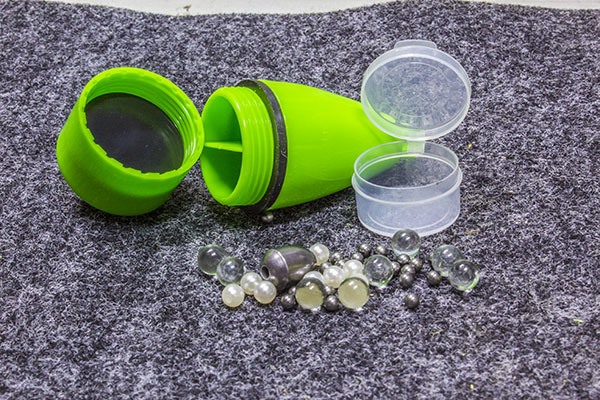
The Versamaxx rattling cork is highly customizable, but I cannot tell you that it makes such a big difference over other designs.
Popping corks such as the Four Horsemen feature large ceramic beads that take the place of smaller beads, making a distinct *pop* noise unlike any other.
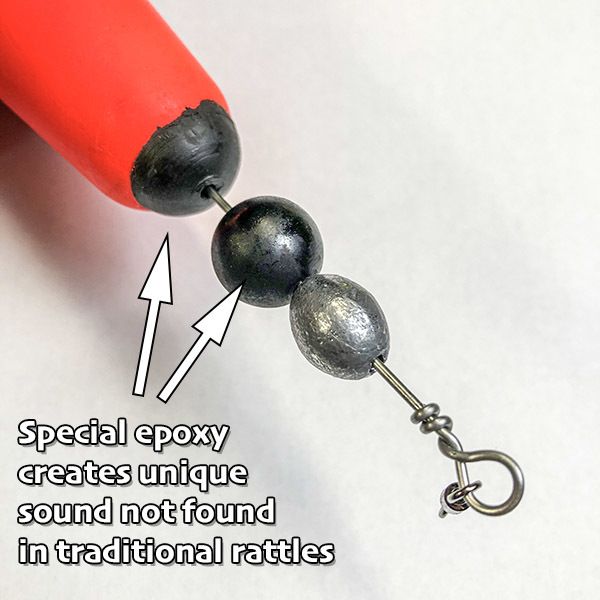
Of course, some popping corks do not possess these features and, for that reason, are better suited for a quieter presentation.
Tangle-ability
How easy can any particular cork tangle? It's something worth measuring, because time spent untangling a cork is time spent (you guessed it) not having a line in the water. And, if your line is not in the water, then your chances of catching a fish are much lower.
I know this seems obvious, but little tidbits of non-fishing time spent here and there really do add up, and that final sum really does make a big difference as to how your day could have gone.
How easily can a cork tangle?
Long stems and other hardware line can snag on or get wrapped around will definitely make a popping cork more likely to tangle.
Sure, you can use thick monofilament leaders above and below the cork to reduce tangling, especially if you're spooled with flimsy braided fishing line such as PowerPro, but that only works so well.
It's better to have a cork that doesn't tangle much in the first place. While I am friends with the owner of Matrix Shad, I can tell you without bias that they made their cork with a shorter stem, specifically for the purpose of reducing tangled line.
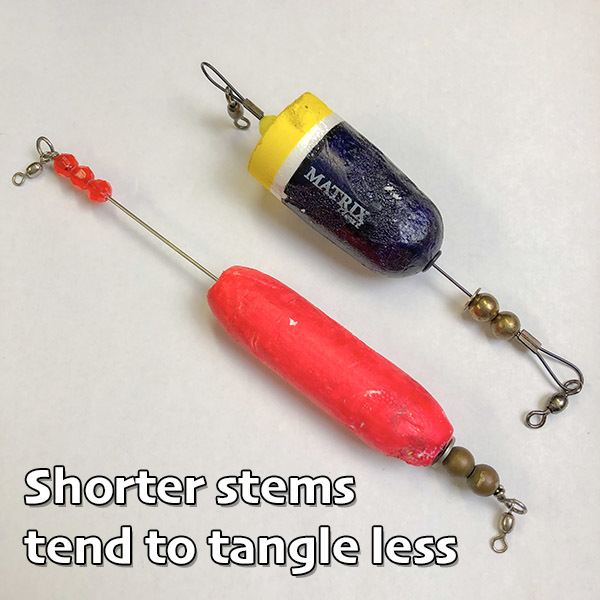
This way you are getting more casts in, and more casts equal more fish. Now, we covered a lot, so let's ask again the question that (most likely) brought you here in the first place:
Which popping cork is the best?
By now it is obvious that there is no single answer to that question, not one that will suit every inshore angler in every situation.
The answer to that question really depends on which of the above features you want to have when fishing for speckled trout and redfish.
I think it is a good idea that you take time to learn those features and make the best decision for yourself (then tell us why in the comments below).
My Overall Favorite Popping Cork
I'll tell you that my favorite all-around cork is a cupped Four Horsemen in bright orange.
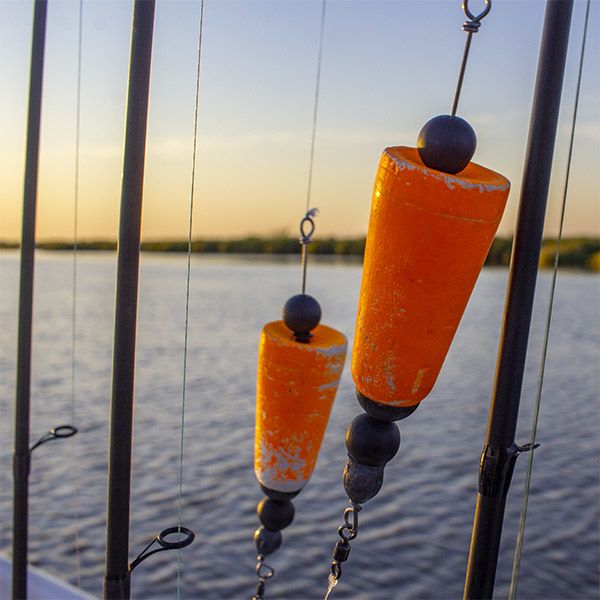
If I didn't love these corks so much then I wouldn't use them as often as I do.
They've been good to me, and you can count on one being tied on if I have a rod rigged for a popping cork for several reasons:
- they are durable
- the stem is hard to bend
- they have a unique sound
- they are easy to rig
- they tangle less often
I also prefer this design because I use rods that are dedicated to fishing a cork. The Four Horsemen's design would not be a good fit for a rod intended to fish both the top and bottom of the water column because it is not removable.
But it is important to note that the Four Horsemen design is original, and the man who designed them is an accomplished fishing guide with plenty of fishing pictures to prove he knows how to catch limits of speckled trout and redfish.
Captain Aaron Pierce built one helluva popping cork! If it were not, so many wouldn't have made the effort to implement his design into their own.
After all, isn't imitation the sincerest form of flattery?
Of course, it goes without saying that there's more to catching fish than tying on a piece of tackle and that's why I think Captain Aaron would agree with what I have to say below:
What Really Matters When It Comes To Catching Fish All The Time Like A Professional Angler
Honestly, this is a tough guide to write, because it is very easy to split hairs and get caught up in the nuances of "what if this" or "what if that".
If you haven't been catching fish, I highly doubt it's because of the cork you're throwing.
It's more likely that you're not on biting fish in the first place, or are simply failing to get the bait to where they can see it.
I am telling you with 100% certainty that there is no cork feature in the world that will ever beat being able to find a ton of biting fish.
If you can do that, it will not matter what stem, clip, bead, rattle or doohickey is on your popping cork because the fish will be hitting whatever enters the water.
So long as there is a hook attached, you will be fine.
No, you do not need a bunch of fishing buddies who are always on the water telling you where they were biting yesterday.
You can learn how to find your own fish, based on the conditions and completely from scratch, without help from anyone showing you where to go fishing.
It's a process taught inside LAFB Elite, a special membership for anglers looking to knock years off their learning curve.
It's a great way to save money and get to what really counts: catching fish and having fun!
The knowledge, tactics and techniques that Captain Devin teaches in his courses will work anywhere on Louisiana's coast.
I fish Vermilion Bay and Big Lake and what he teaches has proven effective for me and my kids!
If you’re new to inshore fishing, or just looking to understand the “why” when things happen, LAFB Elite is worth the money and time invested into the courses.
The amount of information in the courses is huge.
Also the community is filled with people who mostly have the same goals in mind, so when you ask a question you get good information, not some dude giving you some generic or wrong answers.
Not ready to make the leap?
Then consider signing up for my FREE course, the Elements of Effective Fishing, so you don't leave biting fish for the next guy who knows what to do!
What do you use?
If you made it this far, then thank you for reading my guide on popping corks! It's a big topic to cover so, if you have something to add, then I'd love to see it!
Which cork do you use? Why? How many fish have you caught on it?

Thank you, JT!
Hello Devin,
I agree with you that Four Horseman corks perform very well. It is great to have a quality cork that is made locally. We had great trout action using these corks in Grand Isle this summer. Love the action and sound the corks make using both artificial or live bait.
I agree that many things that will determine the success of a fishing trip come before popping cork selection.
At best, I’d say that one feature a popping cork has over another will fall into the category of 3% Theory, like what’s outlined here: https://www.lafishblog.com/three-percent-theory/
Enjoyed reading the article. At the end of the day I’m hard pressed to believe it matters one over the other.
Hey Keith, long time, no see!
I hope you’ve been well.
As always, thank you for commenting and contributing.
Something I’ve done before with the slip corks that lets you adjust depth in seconds. Take your main line, make a loop, poke the loop through the stem, take the tag end of your line and feed it through the loop below the cork. Bam! Instant adjustment of your cork to whatever depth you want.
Warning this will cut into the cork (Styrofoam) if you place the line on the cork. Also braid can pull itself back up into the stem and be hard to get back out.
You can do this same thing with egg sinkers to put weight wherever you want it. Quickly convert a jig to a popping cork/ etc.
Another thing I do is use the little neoprene bobber stoppers and place it below the cork with a free moving egg sinker above (between the cork). And put my hook below this with no weight. I can move my egg sinker higher or lower depending on how free floating I want it to be. Allows the lure/ bait a natural presentation when high, or quick sink when low.
And, a comment on the color, I’m partially color blind and red is very dark for me, so I have to use yellow to see my bobber in the water :)
I use 4 horsemen mostly. The last few H & H clip on’s I’ve bought were terrible. Very disappointed in quality. Couldn’t even use some once.
Why does your cork tangle on windy days? The cork is most often hevier than your bait. This makes the cork the first component to hit the water which is not always the best thing. If I am making long casts I will slow my line down by pinching it stightly, this takes the slack out of the line and allows the bait to hit the water first and results in less tangled lines.
I prefer an Intimidater cork on calm days. This is an odd cork as the lead and tag lines are both tied on the top side of the cork. It is really easy to produce the noise you want with a very slight flick of the wrist.
On a different note, I also have had my butt kicked while using a 4H cork. My brother was using a Pop-N-Prop plus which a Bayou Buck Lure product.
Matrix Popping Cork to me has realistic shrimp flipping sound though it is light for long casts. Cajun Thunder Oval Corks are excellent also. Been fishing Trout for 55 years. My Dad owned two Chandeleur Charter Boats when I was growing up. Color does not matter except to me except for weather and waves visibility.
It seems like to me the best way to do this would be to get a hydrophone and a pool at least 10 feet deep and compare the various cork noises against that of recorded feeding noises.
That would be one hell of a scientific undertaking.
Perhaps one day!
Thank you for commenting.
Hey Mike, that’s absolutely true and something folks should keep in mind. Thank you for commenting.
That’s very true. Thank you for commenting, Richard.
You’re welcome, Ricky. Thank you for commenting!
Hey Bernie, I appreciate you taking the time to come here and share your thoughts. Thank you for commenting!
That’s true about the leader length. That has definitely happened for me before, too. Thank you for commenting!
Excellent fishing tip and thank you for commenting, Brett!
Hey Jason, be sure to use the LAFB Elite Community if you’re having any specific troubles with finding fish. Thank you for commenting.
Find the community forums here: https://www.lafbelite.com/forums/
Great tips! Thank you for chiming in.
Thanks for sharing, Jimmy!
Hey Paul, well said. Thank you for commenting.
BTW, You’ve been absolutely hammering the bejesus out of the trout down there in Grand Isle. Keep up the great work!
Great tip, thank you for sharing.
Excellent comment, thank you for taking the time to type it out.
Tight lines, Dennis!
Like most of us here in SE La, I’ve fished with all the corks listed and have at least one of each in my tackle box. I will say from my recent experience, I like the 4 horseman’s performance over the others I’ve used. I was out fished 3 or 4 to 1 by a friend that was using a 4 horseman popping cork. We both had the same bait, rod, reel and weight line. I bought a 4 horseman cork and my friend and I went out again, my friend still out fished me not as bad as before. Sometimes maybe you pop it to hard or not enough, sometimes you don’t let it sit long enough. Sometimes you don’t keep the line tight. The cork’s job is to keep the bait suspended in the strike zone. But like I said I do have at least one of all the other corks shown above. One day my nephew and I were out to one of our favorite spots he started with a cork, I started jigging we both hooked fish on the first or second cast. I put three fish in the boat before he landed a legal fish. Should he have adjusted the depth or should I have placed a cork on my line? Like I’ve said before, I will use whatever works at the time if I can get over the excitement of catching nice fish even if I have to throw them back to grow. I’m not paid by 4 horseman or LAFB. I have to say I agree with Devin, just use what’s right for the conditions. Knowing is half the battle. There’s a lot of good equipment out there and it all works.
Fishing = “Fun Is Supposedly Happening”.
Dennis
I started replacing the wire thu the corks with nylon covered stainless steel leader wire. Don’t have any cork trouble now.
I’ll start this by saying I’m not the new fad kind of guy. I thought it was outrageous to spend $2,000 on an anchor, I now own a power pole, I thought it was crazy to spend $2,000 on a trolling motor, I now own a minn kota ulterra, I said I would never spend $2,000 on electronics, but I now own a lowrance with total scan imaging. When 4 horsemen got popular I refused to spend $8 on a cork. l’m a firm believer that fishing tackle catch more anglers than fish. But after hearing the sound they make and seeing thier durability I decided to try it out. I gotta say I’m an absolute believer in the 4 horsemen cork. They out last and out perform any cork I’ve tried, and on top of it they now make a protective sleeve. I perfer the orange color and tie on 20lb florocarbon leader about 2 1/2 – 3 ft with a #2 kahle hook when fishing live and jig head with plastic swim shad when using artificial. No extra swivels or any cables, I like my bait to look as natural as possible. With all that said I take fishing very serious and i have had alot of bust trips by not having the best tools to do the job. I figured why not spend the extra money on the correct tools and have a great time catching fish rather than cheaping out and reading all the post of other people catching fish.
I’ve been using 4 horsemen corks for several years now. Actually still have some of the originals from the first ones Aaron Pierce made. They have held up much better than anything else I’ve tried. I love the sound and durability. Definitely a quality product. I use braid on my spinning reels but always use a flouro leader above the cork to reduce tangles.
For years I used the orange top/ green bottom slip on with the plastic stick insert so I could adjust depth and take on and off. I believe the popping of the cupped top attracted fish. I can switch from plastic to dead shrimp easily. Now I keep a four horseman on a dedicated pole for drift fishing or shoreline, and have other poles setup for other lures.
I’ve recently switched to 4 Horsemen and I like them. But, being new to this group is a reality I’ve been facing. To much time trying to fish and not catching. I know that it’s called fishing for a reason, but I’ve felt like the black cloud of fishing recently. I’m enjoying the knowledge here so far and hope to have more enjoyable trips in the near [better educated] future
I rarely use one, dont be afraid especially in the summer to burn the jig with matrix back to the boat similar to fishing a rattle trap with occasional hard rod pops. It is a lot less taxing on the body than popping the cork all day. When I do use it is usually orange and white with concave top.
A couple of comments,
First don’t be afraid to lengthen a leader, I have gone up to 5 feet in deeper water. Yes it can be a pain to cast but sometimes it is necessary.
Second, If you can do it without it getting in the way, cast out a cork rig with a jig and set it in rod holder while your fishing with another rod. It can produce some nice fish. I used to use Gulp for this but matrix shad seem to work almost as well, especially with some chop to keep that cork moving.
Great article Devin. I, like most of the folks commenting here I have tried most types of popping corks. The wrap-on or corks where you have to wind the line around the top or bottom of the cork works great with braid, but I find they are tough on mono or flouro lines causing kinks. Size and color are very important to handle the added weight of larger, live croakers and shrimp. I’ve purchased some shrimp at Campo’s that would better used on a barbecue pit. I’ve also picked up some good tips from the contributors to the discussion here and thank them for writing about their experiences. Keep on fishing & tight lines my friend.
Definitely some variables to think about. Thanks for the info.
Remember that sometimes not popping is a good way to also catch Trout and Reds. You just let the cork drift with the current.
Another advantage of a clip on cork is the ability to adjust the leader length at any time. Sometimes the fish are 3’ under but you’re fishing 18”. Quick change and cast.
Hey Capt Devin
that was a great article and really informative. I learned several things…
I did not see reference to the “popping” noise variances I am told to look for in the shape and the cup on top. I understand that some corks emulate the sound of a fish gulping down a bait and the design of the top produces different gulp sounds as you described the volume of noise and applications of that volume.
Then I have been told that some of the cylindrical shaped “cigar “looking design attempt to produce the underwater sound of fish striking the bait. These are tapered at both ends. The sound of fish striking underwater is also produced by the “rattles” or beads clanking together above or below the cork. These come weighted or non weighted to accommodate fishing with double jigs or heavier single jigs. The sound is much more subtle and suggested with the presence of popping shrimp.
My interest in this is encouraging me to start testing various models as I am Four Horseman fan but always looking to improve. This quest to improve is what has let me to follow you. Your time and attention to detail with explanations before and after your trips has been invaluable.
Tight Lines and Semper Fi
I have tried them all at one point or another over the years . But I always come back to then orange top /green bottom with rattles inside that have internal rattles. Comal 4 inch hard plastic. Can not use on specta lines as they come right off. Always use a 20 fluorocarbon leader and snap it on. Easy to adjust and easy to covert to a slider cork.
As everyone has said, finding fish is way more important than anything else, but I like Four Horsemen because of the sound and the weight to give me more casting range. You get a discount on them if you’re a member of LAFB Elite, too. I use the weighted snap on corks too, especially around the rocks when fishing with my kids or novice guests. Much cheaper to lose a $.99 cork than 4H!
If you’re fishing a popping cork with a spinning reel; which I believe is most common, and you are aggressively popping the cork, I like to place my hand (fingers) in front of the fishing reel stem and not have it between my fingers. You can get a lot more rod action with a lot less wrist movement. Upon hook up, you can quickly transfer your hand back to a normal grip for fighting the fish. This alleviates a lot of pressure on your forearm muscles and after a day of fishing popping corks you will be glad you did.
Agreed, and that’s why I put an emphasis on finding fish in the first place.
Thanks for commenting.
Nice article. For me though I’m not sure it makes a difference.
I either have most of them in my tackle (for different situation) or have used them and some you did not list. I have settled on two for most usage, the 4 horse and one I have found to be some better for my usage, the bomber paradise popper. I fish out of shell beach, the campo’s marina.
I like the deeper sound of the Cajun Thunder. Seems to better replicate the “gulp” of feeding trout. 4H is more durable though, although I’ve had the loop on one break from a 10” trout. I’d give the Matrix a shot if I could find it.
I fish with the paradise popper. I have all 3 shapes (oval, cup and the small cigar). The small cigar cork is awesome for redfish in calm water or small lakes because it makes less noise hitting the water.
Boat Monkey cylindrical! Sounds like popping shrimp.
Glad you enjoyed it and thank you for commenting. The Versamaxx Bolt is indeed a versatile piece of fishing tackle. Glad you brought it up. Tight lines!
Awesome, thank you for sharing.
Nice article, with LOTS of good information! The Four Horseman is a SOLID pick for sure, but I give a slight edge to the Blabber Mouth, based on a bit more noise, and durability. I guess it comes down to personal preference, as most will get the job done.
Very good blog Devin. I recently started finishing again after retiring from the military. It was a learning experience since I haven’t fished in a while. Of course, I had to listen to all the guys that obviously didn’t know anything about fishing. Little by little I started to learn what worked. I still have a long way to go and I enjoy your emails and post. When I first started fishing again, I did what every new fisherman does, I bought one of everything :-). I tried several corks, many of the ones that you have listed here. There was a lot of hyper about the the Vudu Popping Cork. I tried it on several fishing trips and I wasn’t all that impressed. Several fishing trips ago, I decided to try the VersaMaxx Bolt and wow did everything change. This wired cork allowed me to change my depth at will and made a great sound that the fish loved (chomp, chomp). It was a sturdy cork make of good material and the price wasn’t bad. Actually one of the local sporting goods stores had, buy one get one free! I liked the excellent popping action and could actually see the cork. Anyway, I just wanted to add my thought and thank you for the excellent reads. Your website has been an invaluable resource.
It’s a great product and I look forward to fishing more with it. Thank you for commenting, Steve! It’s always an honor.
Nice piece Devin. Of course for me it’s the VersaMaxx Bolt ProSeries. I change depths a lot during the course of the day.